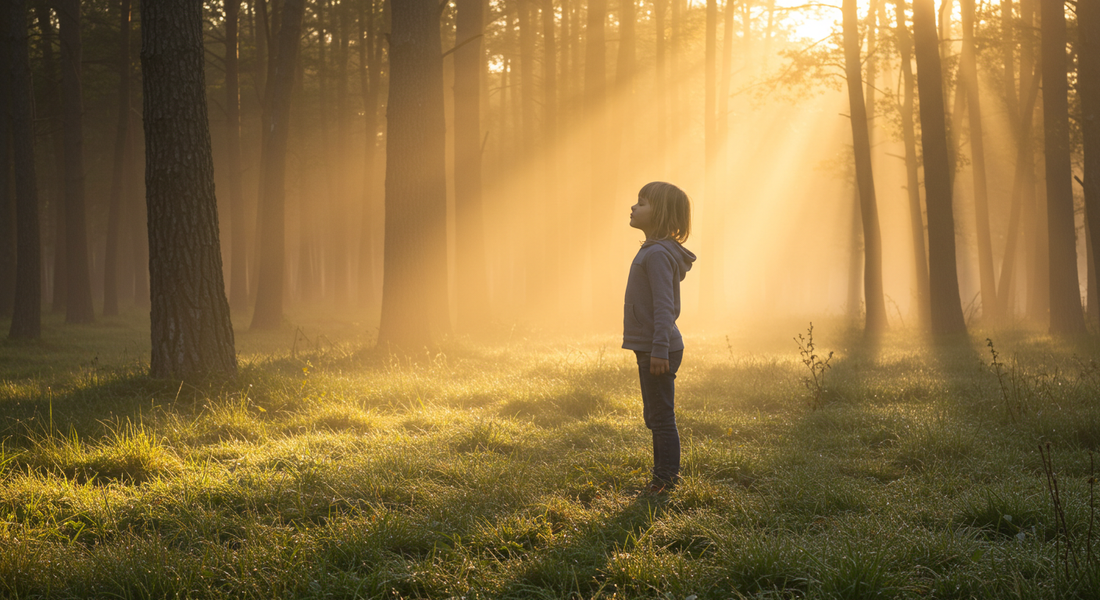
Gain access to the ÆR Circle, regular refills, and breathwork sessions with our coaches.

Does this sound familiar? Your child is sitting at their tablet, engrossed in videos or games, and as soon as the device is put away, they become irritable or restless? In our digital world, children are confronted daily with a flood of stimuli – without really questioning what they are consuming or how it affects them.
At the same time, children's skills such as self-reflection and emotional control are still developing. They need your support to develop these important competencies. However, digital media often have a stronger impact than we realize: they can be overwhelming and quickly lead to overstimulation.
Mindfulness can be a real game-changer here. It gives your child the tools to pause, understand their feelings, and deal with the challenges of everyday life more consciously. What if your child learned to cope better with stress and regulate their emotions more effectively?
In this article, we answer the following questions about mindfulness in children:
Children face particular challenges in coping with the flood of stimuli in our digital world. Their self-regulation and reflection skills are still developing, while digital media often have a stronger impact on them than we realize. The result: overstimulation, restlessness, and difficulty understanding and managing emotions. Playful mindfulness exercises can provide valuable support here. By learning to consciously pause, feel their breath, or explore sounds like detectives , children develop important skills such as calmness, concentration, and emotional balance – all in a way that brings them joy. In this way, mindfulness becomes a true game-changer in everyday life. You can learn more about the importance of mindfulness in everyday life in this article.
The benefits of mindfulness for children are multifaceted and have a positive impact on their emotional, mental, and social development. Through regular mindfulness exercises, children can learn to better perceive and understand their feelings, which helps them to cope more calmly with stress and frustration. They develop greater inner peace, which not only improves their concentration at school but also their ability to self-regulate .
Mindfulness helps children relax and stay calm in hectic situations. At the same time, it strengthens compassion – both for themselves and for others. Mindful children often exhibit less impulsive behavior and are better able to resolve conflicts.
Furthermore, they learn to consciously direct their attention and stay in the present moment, which is an invaluable advantage, especially in our distraction-filled world. In short, mindfulness provides children with valuable tools to strengthen their well-being, develop their social skills, and better cope with the challenges of everyday life.
Children can learn mindfulness in a playful and age-appropriate way by integrating small, enjoyable, and easy-to-implement exercises and rituals into their daily lives. It's important that mindfulness doesn't feel like a chore, but rather is experienced as something exciting and positive.
A good starting point is simple breathing exercises: For example, children can imagine themselves blowing up an imaginary balloon or smelling like a flower. Movement can also be mindful, for example on a " barefoot path " where they consciously feel different surfaces, or in " animal yoga " where they stretch like cats or hop like frogs.
Everyday moments are also excellent opportunities: mindfully eating a piece of chocolate together, feeling its texture and discovering its flavor, or consciously perceiving sounds in the surroundings during a walk. Such exercises not only promote mindfulness but are also fun for children. Most important, however, is the support of parents, who, through modeling and encouragement, help make mindfulness a natural part of a child's life. With patience and regular practice, children will gradually develop a deeper awareness of themselves and their environment.
Introducing mindfulness exercises to children can encounter some obstacles. One of the most common challenges is that children become impatient or have difficulty staying calm. Younger children, in particular, tend to get distracted or bored easily . In these cases, it helps to make the exercises short and playful. Instead of a longer meditation, short, imaginative stories or movement games like "Lion's Breath" or "Rustling Leaves" might be more effective at holding attention.
Another obstacle is that some children initially find mindfulness exercises unfamiliar or "boring." To counteract this, it is important to integrate the exercises into everyday life and link them with positive experiences. For example, conscious breathing can be incorporated into an evening bedtime routine, or mindful observation can become part of a nature walk.
Another challenge is resistance to a new routine. Children might hesitate if mindfulness is presented as a "task" rather than a game. Here, it helps to do the exercises together and make them a shared experience. The role model of parents plays a crucial part: if children see that adults also take time for mindfulness, they are more likely to participate.
Ultimately, cultivating mindfulness requires time and patience. Results are often not immediately visible, which can be frustrating. It's important to keep expectations realistic and celebrate successes – however small they may be. With perseverance, flexibility, and a playful approach, these challenges can be successfully overcome.
The following exercises are specifically designed to address the typical challenges of mindfulness practices with children. They are short, playful, and easily integrated into daily life, making them suitable even for impatient or easily distracted children. Through creative approaches such as guided imagery or movement exercises, mindfulness becomes an enjoyable experience that also fosters important skills like calmness, concentration, and self-regulation. With these exercises, children can learn to be more mindful of themselves and their environment – without pressure , but with joy and ease.
Breathing exercises are a simple and effective way to playfully promote mindfulness. Here are some child-friendly exercises:
Together you can pretend to smell a beautiful flower. Inhale deeply, enjoy the fragrance, and then exhale gently.
Your child takes a deep breath and roars like a lion as they exhale. This exercise is not only fun, but also helps release pent-up energy.
Your child imagines gently blowing out a candle. They exhale slowly and evenly, without moving the "flame" too much.
These exercises are not only relaxing, but also strengthen awareness of your own breath and promote concentration – all in a playful and enjoyable way. You can learn more about the different breathing exercises here.
Sound Detectives: In this exercise, your child becomes a detective. Close your eyes for one minute and listen carefully to the sounds around you – the chirping of birds, the hum of a car, or a soft rustling. Afterward, you can share the "clues" and try to figure out together where the sounds are coming from. This exercise sharpens the senses and promotes conscious perception.
The mindful walk: Go outside together and imagine you are exploring nature like explorers. Your child pays attention to how the ground feels under their feet, the colors of the leaves, or how the wind feels on their skin. You can playfully collect or count things, like stones or flowers, to focus your attention on the present moment.
Painting and storytelling offer playful ways to foster mindfulness in a creative manner. Through emotional painting, children can express their feelings with colors and shapes, gaining a deeper understanding of them . Imaginative stories or guided imagery invite them to use their imagination, find inner peace, and consciously engage their senses. These approaches are not only relaxing but also promote self-awareness and self-expression – all in a fun and easily integrated way.
Children learn mindfulness best by observing the behavior of the adults around them. When parents and caregivers model mindfulness themselves , it inspires children to playfully adopt this attitude. Whether through conscious listening, calm reactions to stressful situations, or creating moments of peace – their own mindfulness serves as a powerful example.
Several times a day, consciously take a minute to breathe deeply in and out together. This creates a calm atmosphere for everyone and teaches children how to cope with stress .
Integrate simple exercises into everyday life, such as mindfully enjoying a meal where everyone describes how the food looks, smells, and tastes.
Introduce a shared evening ritual, such as listening to sounds or telling a fantasy story. This not only helps with relaxation but also strengthens the bond between adults and children.
Through such small, shared exercises, mindfulness becomes a natural and unifying practice in everyday family life.
Mindful Schools. (n.d.). Mindful Schools – Training and resources for integrating mindfulness into everyday school life. Retrieved February 1, 2025 , from https://www.mindfulschools.org/
Smiling Mind. (n.d.). Smiling Mind – A free mindfulness program for children and young people. Retrieved on February 1 , 2025 from https://www.smilingmind.com.au/
Greater Good Science Center. (n.d.). Mindfulness and Children: Research and Practical Resources. Retrieved February 1 , 2025 , from https://greatergood.berkeley.edu/topic/mindfulness_and_children
Our promise: We deliver honest, scientifically verified and practical content about mental control .

Fabian Hans: With his background in psychology and marketing strategy, he writes to show how our environment influences our thoughts. This blog aims to help people think more clearly and act more consciously.
You can set the offer title and subtitle in your Upsell Offer!